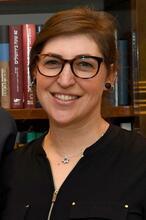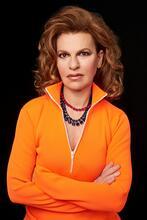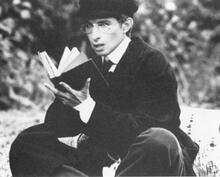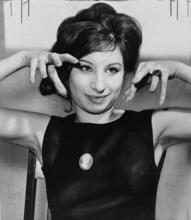Barbra Streisand
Actress, singer, film director/producer, and founder of the Streisand Foundation, Barbra Streisand in 1962.
Photo from Wikimedia Commons.
From the moment she burst on the Hollywood scene in Funny Girl, winking as she uttered the immortal “Hello, gorgeous” to her mirror likeness, there has been no one quite like Barbra Streisand. As The Guardian reminded readers in 2019, her outdoor Hyde Park concert that year occurred over 50 years after the Concert in Central Park, in her heyday: “She was, after all, the breakout star of The Other 60s, when Broadway and light entertainment rolled on as if the Beatles had never happened, a ‘nutty little kook’ who could do the lot: sing, act, and entertain an audience with Jewish comedy between songs.” In her 80s, in the 2020s, Barbra is still a formidable presence wherever she goes, garnering accolades for her singing, acting, charity work and, most recently, her 2023 autobiography.
Introduction
During her five decades in the limelight, Barbra Streisand has been awarded two Oscars, five Emmys, ten Grammys (including the Legend Award and the Lifetime Achievement Award), a Tony Award, eleven Golden Globes (including the Cecil B. DeMille Award), three Peabodys, the Director’s Guild Award for her concert special, and the Genesis Award. In 2008, when she received the Kennedy Center Award, Queen Latifah introduced her as someone who “jumps over barriers,” reframing what a star looks like and what a woman can do. According to Wikipedia, “Billboard ranked Streisand as the greatest solo artist on the Billboard 200 chart and the top Adult Contemporary female artists of all time.”
In the Beginning
Barbara Joan Streisand was born off-off-off Broadway, in Brooklyn, NY, the second child of Emanuel and Diana (Rosen) Streisand, on April 24, 1942; her brother, Sheldon, had been born seven years earlier. Her parents were both born in 1907. Her mother was the daughter of a cantor (who also worked in the garment district) and a housewife. At the time of Barbara’s birth, Emanuel Streisand, who held a Bachelor of Science degree in English Education and a Master of Science degree in Education from the City College of New York, was a teacher. Emmanuel, who was described to Barbra as a “very religious man,” once walked back to Brooklyn after a Friday afternoon class to avoid public transportation on the Sabbath.
When Barbara was only fifteen months old, her father took a summer job in the Catskill Mountains, bringing his family with him. There, the 35-year-old Emmanuel Streisand died suddenly of respiratory failure resulting from a morphine injection given to halt an epileptic seizure. (His children only found out years later that this, and not a cerebral hemorrhage, as they had long believed, was the actual cause of their father’s death.) As a result, the family was immediately plunged to an economic level just above poverty.
Diana Streisand moved with her children to her parents’ house in the Williamsburg neighborhood of Brooklyn and took a job as a bookkeeper to support her family, leaving little time for parenting. The situation was further exacerbated when, in 1949, Diana married Louis Kind, who was, according to Streisand, “allergic to kids.” The couple had one child together, Rosalind (later changed to Roslyn), before separating, reconciling, and, finally, divorcing.
Streisand attended the ultra-Orthodox girls’ Yeshiva of Brooklyn for her first three years of school (1946–1949). She later graduated from Erasmus Hall High School in 1959 (along with Neil Diamond), with a love of the theater and an impressive A average. Her formal education may have ended in high school, but her academic rewards continued many years later. In May 1995, she received an honorary doctorate from Brandeis; earlier that year, she delivered a lecture more than rave reviews for Wholesale—she also won the heart of the male lead, Elliott Gould. The two married in 1963. In 1966, they had a son, Jason Emmanuel; they separated in 1969 and divorced in 1971. But they co-hosted Jason’s [jwa_encyclopedia_glossary:299] bar mitzvah[ celebration in 1969.
But formal education was not Streisand’s direction. As soon as she graduated from high school, despite her mother’s protests, Streisand left home to pursue acting in Manhattan, working at odd jobs while preparing for stardom. After failing to be accepted into the famous Actors Studio, she took acting lessons from a friend, Alan Miller, working hard at perfecting her craft. She then moved in with another actor friend, Barry Dennen, who steered her toward singing, sharing his considerable song collection with her, and helping her shape a song into a theatrical event. Streisand’s first venue in which to try this combined approach to performance was the weekly talent show at the Lion Club, one of the premier gay clubs in New York, in 1960.
From the Underground to Broadway
The underground bar scene fostered a sense of self and a sense of humor that readily appealed to Streisand and whose adherents were drawn to Streisand: The kooky outsider finally found a place where her persona was appreciated and applauded. As journalist Shaun Considine recalled in his chatty biography, Streisand mesmerized the audience from the first song to the final ovation. Initially hired for a one-week engagement in September 1960, Streisand stayed at the Lion Club for three, building an idiosyncratic songbook and perfecting a wacky delivery style of impromptu one-liners. By word of mouth alone, the Lion Club was mobbed every evening to hear Streisand. She had become a gay icon overnight and has remained a gay icon ever since.
Following her success at the gay cabaret, Streisand was offered a job by the nearby Bon Soir club, at double her weekly salary. Once again, her engagement was quickly extended, from three weeks to thirteen. She was working hard on her act and the audience responded appreciatively wherever she was booked: New York, Detroit, Cleveland, and St. Louis.
In 1961, Streisand made her television debut on The Jack Paar Show to promote her role as Miss Marmelstein in Broadway’s I Can Get It for You Wholesale, the Broadway show that put her on the fast track to superstardom. The part of Miss Marmelstein was enlarged and new songs were added for her. The show ran from 1961 to 1963, garnering much praise.
Although Streisand’s show-stopping turn as Miss Marmelstein gave her national media exposure, it took months for Columbia Records to sign her to a contract. She was, it seems, too much of everything for their taste: too Brooklyn, too Broadway, too Jewish, too special, too eccentric, too unattractive. Her songs were too old and too obscure and her style was too homosexual. Finally, in the spring of 1964, The Barbra Streisand Album was released and made history: it remained on the charts for nearly eighteen months, establishing Streisand as one of the most popular American singers of all time.
From Barbara to Barbra
How did Barbara become Barbra? According to Matt Howe’s Barbra Streisand Archives, Barbara always hated her name. Because she adored her father, she never changed her family name, but very early in her career, during her run at the Lion Club in New York as the opening act for Phyllis Diller, she dropped the second “a” from her first name, and she has been known as Barbra Streisand ever since (Diller told reporters that dropping the “a” was her idea).
The path from Barbara to Barbra, however, was neither linear nor always successful. But her first foray to fabulousness, the musicalFunny Girl, in 1964, was a sensation. The show was loosely based on the life of Fanny Brice, the quintessential Jewish multi-talented performer who was a staple of The Follies, where she introduced songs that became hits for Streisand in the musical. Brice’s real life was different from the Broadway version (Kenrick, 2003), but she was decidedly the Jewish diva of the entertainment world in her heyday in the first half of the twentieth century. Funny Girl played seventeen previews and 1,348 performances before closing in July 1967. As Eric Neher wrote in the Hudson Review, “What had made Funny Girl so amazing was not the juxtaposition of Streisand for Brice, but the fact that the Streisand made Brice hers, making adjustments to Brice’s story to mimic her own. In the end, this is not about the real Fanny Brice, but about the self-inventive Barbra Streisand. And the audience loved it.”
A year after the curtain dropped on Funny Girl on Broadway, it rose in Hollywood. The reviews were ecstatic and the box office made producers rhapsodic. By this point, Barbra was a superstar. Her albums were extremely popular, and her film was a sensation. A more mature star would have weighed her options and her future plans carefully to maximize this first moment of film success, but instead, Streisand snatched the lead in the movie version of Hello, Dolly! from Carol Channing, who had played Dolly on Broadway for 3000 performances. Playing a middle-aged matchmaker was not a wise career move, and the film flopped. Its album peaked at number 49 on the chart, a dismal placing for a star.
Having won an Oscar for Funny Girl, Streisand was not even nominated for Hello, Dolly! Her next film, On a Clear Day You Can See Forever, was nearly not released, and the soundtrack sold poorly. The next movie, The Owl and the Pussycat in 1970, was barely noted by critics and fans at the time of release. Streisand’s mistake was in believing that she could turn any Broadway hit into a smash hit movie; a few other flawed films followed.
Then, in 1972, came What’s Up, Doc? with Ryan O’Neal. The screwball plot keeps the audience on its toes. As further incentive, Streisand sings (Seven years later, the two would team up again in The Main Event). In 1973, The Way We Were brought Streisand not only more money, fame, and fans than ever before, but also her first number-one hit song. By then, she had also participated in her first political fund-raiser, for George McGovern (an act that would place her on Richard Nixon’s enemies list (ironically, along with Channing). By the end of the 1970s, Streisand had also starred in a rock remake of A Star Is Born with Kris Kristofferson and collaborated with singer-songwriter Barry Gibb on her best-selling album Guilty.
In September 1981, idolized and iconized, Streisand recorded “Memory” from the Andrew Lloyd Webber hit show Cats. According to Shaun Considine, she declined to record “Don’t Cry for Me Argentina” from Evita because Eva Peron “was a fascist.” Streisand’s album Memories went platinum even though it featured only two new songs.
Streisand’s next project took a lot of hutzpah: she produced, co-wrote, starred in, and directed the film version of Isaac Bashevis Singer’s short story, Yentl, dedicating it “to my father... and to all our fathers'' (1983). Even though the movie made money, garnered good reviews (Ebert deemed it “magical”), and inspired women everywhere, Streisand did not receive an Academy Award nomination (although the film did win an Oscar for its music). Some film critics depicted Streisand not as a multi-talented artist but as a dictator who exerted total control over every detail of the film’s production. As The Washington Post critic summed it up at the time, “Yentl is Streisand. Either you like her or you don't. And if a little Streisand means a lot, then a lot is what you've got.”
Briefly taken aback, Streisand was soon in the limelight again, in her own way, on her own terms, with The Broadway Album. In the first cut on the recording, Streisand speaks with two advisers, who tell her the record won’t sell—yet it peaked at number one on the charts and won two Grammy Awards. In 1991 Streisand tried her hand again at directing and starring (as well as producing) a film, Pat Conroy’s The Prince of Tides, in which her son also had a part. Again, despite the movie’s good reviews and box office success, Streisand was snubbed by the Academy of Motion Picture Arts and Sciences. She turned her energies to helping elect Bill Clinton.
In November 1996, Streisand starred in, directed and produced The Mirror Has Two Faces. Again, the movie was a hit with fans, but the reviews were generally tepid. This love-hate relationship between Streisand and the media was encapsulated by two biographies assigned by publishers to male writers in 2012, when Streisand celebrated the 50th anniversary of her star turn in Funny Girl. Ethan Mordden, in his Opinionated Guide to Streisand’s career, presented a far from flattering overview of Streisand’s first 50 years in show business. He considered her arrogant and self-absorbed, faulting her for turning down substantial cinematic roles in favor of “popcorn” popular films, including Yentl, which he criticized for being wholly Jewish, with no outsider in the frame. For her fans, such criticism is precisely why they adore her: she is not afraid to be a strong, opinionated Jewish woman who knows what she wants and how to achieve it.
Madden’s biting comment was repeated, often.As the Chicago Tribune began a story in 1996, “Everything you have heard about Barbra Streisand being a total control freak is absolutely true.” Unapologetic about her insistence on total control over her movies and albums, Streisand retorted: “Of course I want utter and complete control over every product I do. The audience buys my work because I control it, because I am a perfectionist, because I care deeply” (Lee). And some critics extol her devotion to perfectionism, as did Roger Ebert in his review of Funny Girl in 1968. He opened it by noting that “The trouble with Funny Girl is almost everything except Barbra Streisand. She is magnificent” (RobertEbert.com)
William Mann’s 2012 Hello, Gorgeous, an overview of Streisand’s first five years as a star, contrasts with Mordden’s biography. For example, he recounts the taping of the Judy Garland Show for television in 1963. Garland was shaking due to a mix of prescription drugs, while Barbra was confident and polite. After a duet that was undermined by a stage cue to remove props one by one, they finished the song with two chairs, laughing. According to Mann, “Garland declared, ‘There’s one thing they can’t cut out of the budget, and that’s our voices.’ Barbra laughed in agreement. What followed was pure magic.… With astonishing precision, they ended triumphantly, then fell into each other’s arms, smiling” (395).
From Star to Diva
Streisand was world renowned not only for her singing and acting, but also for her love affairs with some of the most famous men in the world. But in 1998, she married a man she had met a while earlier, when friends set her up on a blind date with another star, actor Josh Brolin. They are still married; their families are blended.
As of 2024, Streisand had appeared in nineteen movies, mastering each genre—comedy, drama, musical—in turn. Whatever the plot, Streisand is decidedly herself: defiant and Jewish. She has portrayed many undeniably Jewish characters in her movies: Fanny Brice in Funny Girl and Funny Lady; Dolly Levi in Hello, Dolly!; the teenage yeshiva boy who is really a girl in Yentl; and a Jewish psychiatrist in The Prince of Tides. She made the lead role in her version of the classic film A Star Is Born Jewish and insisted on playing Rose in The Mirror Has Two Faces, formerly a French farce, as Jewish. In her final film to date, The Guilt Trip (2012), Streisand and Seth Rogin play a typical Jewish mother-son duo.
Before Streisand, conventional wisdom stated that for an actor, “looking Jewish” meant being relegated to supporting roles. But now, 60 years after her Broadway debut, looking Jewish, ethnic, or in any other way different has become acceptable, even chic. Streisand’s Jewishness is not a role, but a personality. In interviews and in her autobiography, she emphasizes that she “has always been proud of my Jewish heritage … It’s essential to who I am” (Sone). Because of her and other fearless public figures, being out in public as a Jew is no longer an impediment to success, although antisemitism is not a long-gone bias.
In public performances, and on the screen as both singer and actor, Streisand has a carefully constructed persona. She is touted as a natural talent, but she has taken many acting lessons. She sings to standing-room-only crowds, but she rarely performs in public because of her stage fright. She has a reputation with Hollywood insiders for arrogance, but she is deeply insecure. Ironically, she is loved by millions, both ordinary and famous. The late designer Isaac Mizrahi, in the March 1997 issue of Out magazine, recalled that in his youth, Streisand was “one of my icons. She was kind of a misfit, and yet she convinced everyone she was beautiful, including me. She is beautiful, but she’s not the prototypical ideal of female beauty.” Many agree: Streisand has been featured on dozens of magazine covers, including Playboy, and has millions of fans around the world, waiting for new material as they listen and view earlier work over and over again. She gives people who are not born beautiful by local standards the feeling that they can project their own personality outwards in their own way and be seen and embraced. She knows her audience and works diligently to deserve their devotion.
In her long career, Streisand has spawned a legion of fans. There are Streisand fan clubs, Streisand fanzines, Streisand cyber-fansites, Streisand collectors, Streisand groupies, and just plain Streisand aficionados. One fan opened a Streisand boutique in California called, appropriately, Hello Gorgeous. To her fans, Streisand is a trailblazer who has developed her own unique sense of style and beauty. Her lifework, as expressed in her music and movies, as well as in her political activism, is a defiant reexamination and redefinition of beauty, style, woman, activist—on her own terms.
More than Entertainment
In addition to her sell-out public performances and movies, Streisand is known for her innumerable philanthropic contributions to a wide variety of social, educational and political causes, both local and global. Speaking at Harvard University’s J.F.K. School of Government in 1995, she explained her philosophy:
I know that I can speak more eloquently through my work than through any speech I might give. So, as an artist, I’ve chosen to make films about subjects and social issues I care about, whether it’s dealing with the inequality of women in Yentl, or producing a film about Colonel Grethe Cammermeyer, who was discharged from the army for telling the truth about her sexuality.
When asked why she performs, Streisand has indicated that it is not for the money. “I have enough money, thank God, and the only reason I want it is to give it away. There’s nothing more I need,” she told the New York Times in 1983. Her multi-city concert tour in 1994 set box-office records by generating more than ten million dollars for charity. The Streisand Foundation funds charities close to her heart—those devoted to achieving women’s equality, human rights, civil liberties, children’s welfare, and environmental protection.
Conclusion
In sum, Barbra Streisand is more than just another consumer-culture icon. She is a diva, a superstar, a sensation. Since the 1960s, she has won more varied awards (Emmy, Grammy, Oscar, special Tony, Golden Globe, CableACE, Peabody) than anyone else in show business, and has sold over 68 million records, more than any other female singer. She is timeless, enduring, phenomenal. She has triumphed as herself in a town that thrives on make-believe, and she has done it all without mirrors.
Selected Filmography
Funny Girl (1968).
Hello, Dolly! (1969).
On a Clear Day You Can See Forever (1970).
The Owl and the Pussycat (1970).
What’s Up, Doc? (1972).
The Way We Were (1973).
For Pete’s Sake (1974).
Funny Lady (1975).
A Star Is Born (1976).
The Main Event (1979).
All Night Long (1981).
Up the Sandbox (1982).
Yentl (1983).
Nuts (1987).
Prince of Tides (1991).
The Mirror Has Two Faces (1996).
Meet the Fockers (2004).
Little Fockers (2010).
The Guilt Trip (2012).
Considine, Shaun. Barbra Streisand: The Woman, The Myth, The Music. New York: Delacorte Press, 1985.
Hamlisch, Marvin, with Gerald Gardner. The Way I Was. New York: Maxwell Macmillan International, 1992.
Kenrick, John. “Funny Girl Debunked: Fannie Brice Facts.” www.Musicls101.com, 2003.
Lee, Luaine. “Streisand makes no apology for her perfectionism.” Scripps Howard News Service. (11/12/1996. Updated 1/10/2011).
Levy, Emanuel. “Dame Barbra.” Jerusalem Post, February 4, 2005.
Mann, William J. Hello, Gorgeous: Becoming Barbra Streisand. Boston and New York: Houghton Mifflin Harcourt, 2012.
Matt, Howe. www.barbra-archives.info.
Mordden, Ethan. On Streisand: An Opinionated Guide. New York: Oxford University Press, 2012.
Mr. Showbiz. http://www.mrshowbiz.com.
Nehr, Erick. “Funny Girl and the Streisand Phenomenon.” The Hudson Review, Summer 2022.
Pimentel, David. Barbra Streisand Website, barbrastreisand.com.
Potok, Chaim. “Barbra Streisand and Chaim Potock.” Esquire, 1982.
Riese, Randall. Her Name Is Barbra: An Intimate Portrait of the Real Barbra Streisand. New York: St. Martin’s Press, 1993.
Robertson, Pam. “A Star is Born Again: Imitation and Difference in Streisand’s Image.” Paper presented at the Film and Performance Conference, University of New South Wales, Australia, September 1996.
Sone, Samara. “Barbra Streisand’s Jewish background and enduring legacy.” jewish unpacked.com, March 4, 2024.
Spada, James. Streisand: Her Life. New York: Crown Publishers, 1995.
Streisand, Barbra. My Name Is Barbra. New York: Viking Press, 2023.
The Chicago Tribune. “Now, Streisand Embraces ‘Control Freak’ Label.” November 19, 1996, August 2021.
Time. CD-ROM (1994).
Zec, Donald, and Anthony Fowles. Barbra: A Biography of Barbra Streisand. New York: St. Martin’s Press, 1981.










